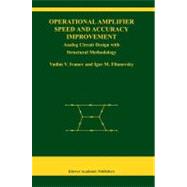
| Preface | |
| Notations | |
| Introduction | |
| Organization of the book | |
| Analog design steps and tools | |
| Modern analog processes | |
| Trends and requirements of the OpAmp design | |
| Essential parameters of bipolar and MOS transistors | |
| Structural design methodology | |
| Consider good circuits only | |
| System description and analysis with signal flow graphs | |
| Frequency stability in the multiloop system | |
| Elementary building cells | |
| Summary | |
| Biasing | |
| PTAT biasing circuits | |
| MOS gm-matching biasing | |
| Negative-TC and zero-TC current generators | |
| Current mirrors and sources | |
| Subregulated biasing | |
| Low-noise bootstrap charge pump | |
| Start-up circuits | |
| OpAmp gain structure, frequency compensation and stability | |
| Voltage and current gain boost | |
| Frequency compensation | |
| Rail-to-rail IO OpAmp structure | |
| Input stage | |
| Rail-to-rail input stages with stable gm | |
| CMRR/PSRR improvement | |
| Trimming techniques | |
| Offset and temperature drift trimming | |
| Input protection | |
| Intermediate amplification stages | |
| Floating current source | |
| Current mirrors of the folded cascode | |
| Direct voltage gain boost in folded cascode | |
| Voltage gain boost utilizing current mirrors | |
| Voltage follower | |
| Class AB output stage | |
| Class AB stage structure | |
| Generation and improvement of class AB circuits | |
| Special functions | |
| Startup and shutdown | |
| Temperature shutdown | |
| Output current limiting | |
| Slew rate enhancement | |
| Overload recovery | |
| From structure to circuit | |
| General considerations of transistor sizing and biasing | |
| Design step one: input and output devices and currents | |
| Folded cascode | |
| Class AB output stage | |
| Gain boost and folded cascode current source | |
| Biasing | |
| Finale of the amplifier design | |
| Appendix: Structural properties and linear transformations in the multidimensional systems with symmetric links | |
| References | |
| Index | |
| Table of Contents provided by Publisher. All Rights Reserved. |
The New copy of this book will include any supplemental materials advertised. Please check the title of the book to determine if it should include any access cards, study guides, lab manuals, CDs, etc.
The Used, Rental and eBook copies of this book are not guaranteed to include any supplemental materials. Typically, only the book itself is included. This is true even if the title states it includes any access cards, study guides, lab manuals, CDs, etc.